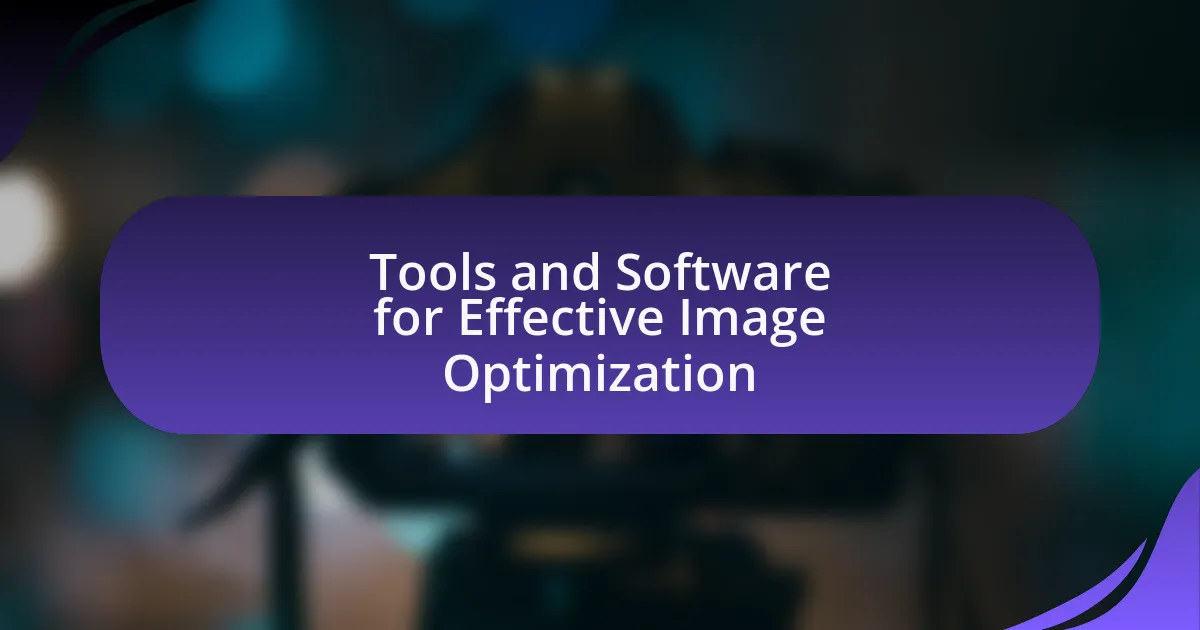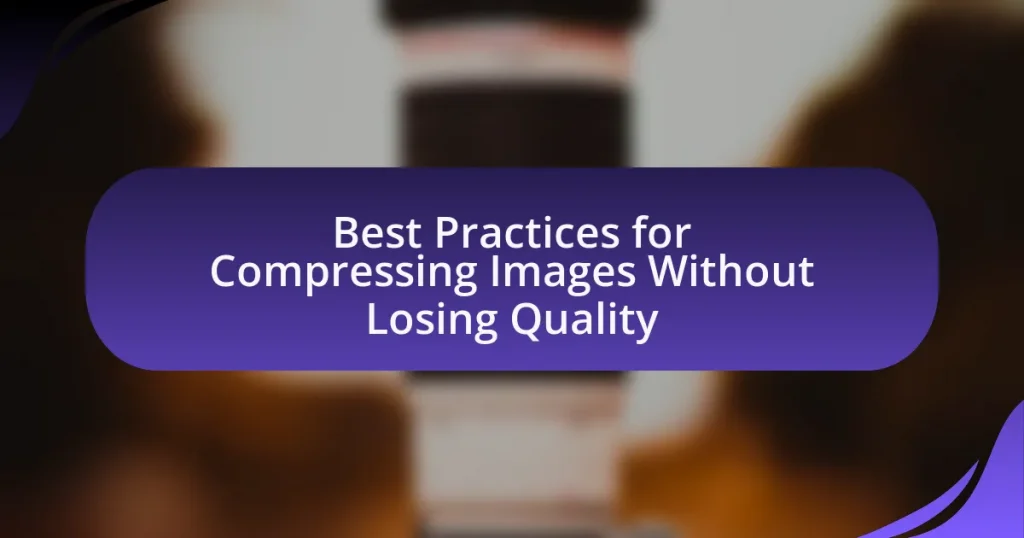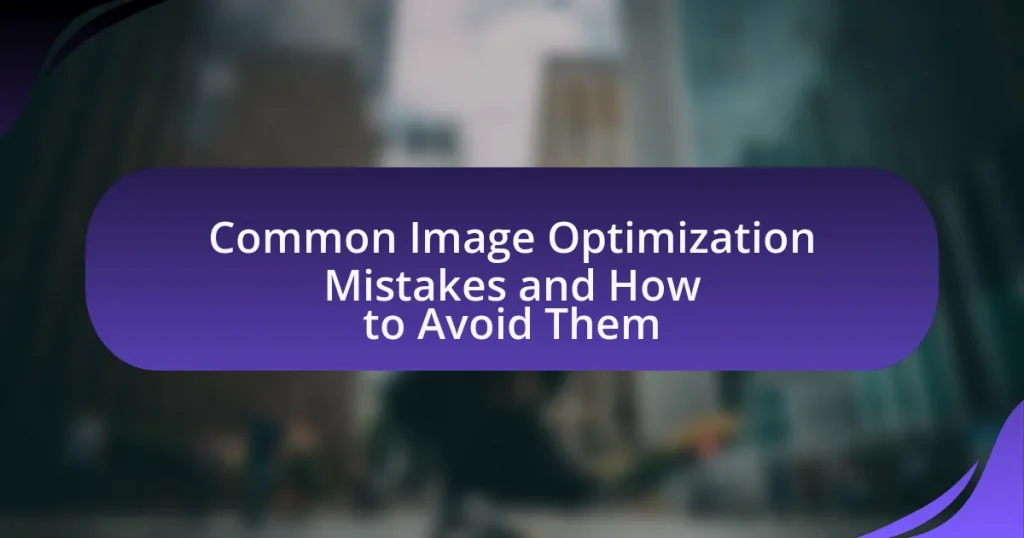The article focuses on tools and software for effective image optimization, highlighting popular options such as Adobe Photoshop, TinyPNG, ImageOptim, and Kraken.io. It explains how these tools enhance image quality through advanced algorithms, including features like contrast adjustment, noise reduction, and compression techniques. The importance of image optimization for website performance, user experience, and SEO rankings is emphasized, along with the differences between lossy and lossless optimization methods. Additionally, the article provides guidance for beginners on selecting appropriate tools and best practices for maintaining image quality across various platforms.
What are Tools and Software for Effective Image Optimization?
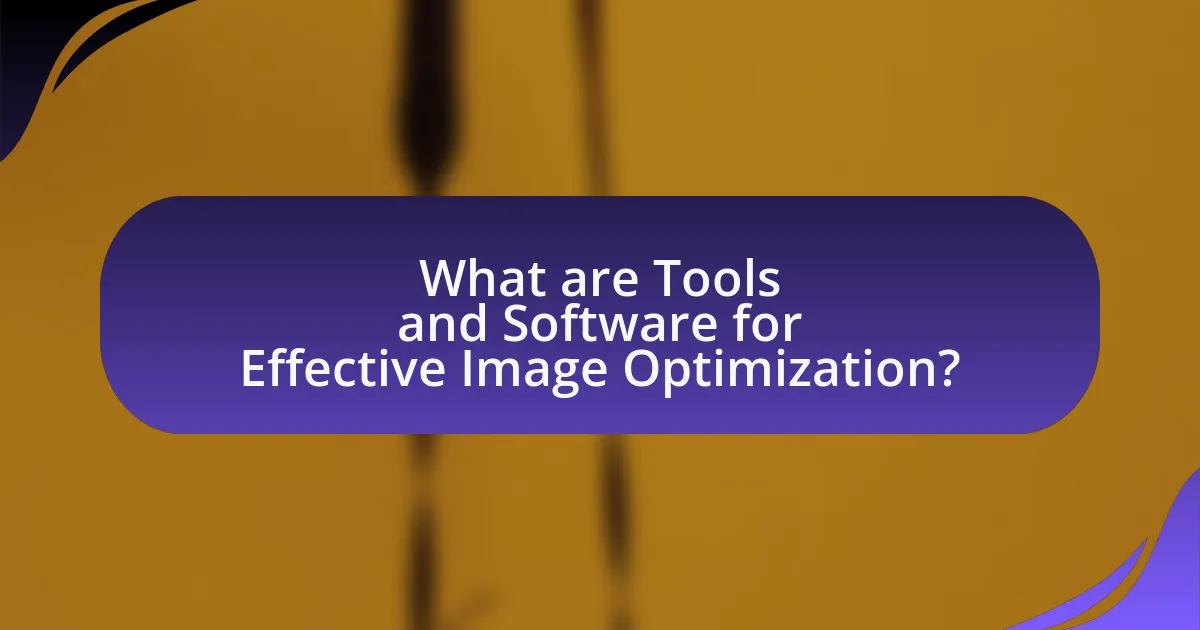
Tools and software for effective image optimization include Adobe Photoshop, TinyPNG, ImageOptim, and Kraken.io. Adobe Photoshop offers advanced editing features and allows users to save images in optimized formats. TinyPNG uses smart lossy compression techniques to reduce file sizes without significant quality loss, making it ideal for web use. ImageOptim is a Mac application that compresses images while maintaining quality, suitable for developers and designers. Kraken.io provides a web-based solution for bulk image optimization, supporting various formats and offering both lossy and lossless compression options. These tools are widely recognized for their effectiveness in enhancing image performance on websites and applications.
How do these tools and software improve image quality?
Tools and software improve image quality by utilizing advanced algorithms to enhance resolution, reduce noise, and optimize color accuracy. These technologies apply techniques such as upscaling, which increases pixel density while maintaining clarity, and noise reduction, which eliminates unwanted artifacts that can degrade image quality. For instance, software like Adobe Photoshop employs sophisticated filters and adjustments to refine images, while AI-driven tools like Topaz Gigapixel AI use machine learning to intelligently predict and fill in details during the upscaling process. These methods collectively result in sharper, clearer, and more vibrant images, demonstrating the effectiveness of image optimization tools.
What specific features contribute to image enhancement?
Specific features that contribute to image enhancement include contrast adjustment, brightness modification, color correction, noise reduction, and sharpening. Contrast adjustment enhances the difference between light and dark areas, making images appear more dynamic. Brightness modification allows for the overall lightness or darkness of an image to be altered, improving visibility. Color correction ensures that colors are accurate and vibrant, often using tools like white balance adjustments. Noise reduction minimizes unwanted artifacts, resulting in cleaner images, while sharpening enhances the clarity and detail of edges. These features are commonly found in image editing software, such as Adobe Photoshop and Lightroom, which are widely used for effective image optimization.
How do these features impact loading times and performance?
Image optimization features significantly enhance loading times and overall performance by reducing file sizes without compromising quality. For instance, tools that employ lossless compression can decrease image sizes by up to 50% while maintaining visual fidelity, leading to faster loading times. Additionally, features like lazy loading only load images as they enter the viewport, which minimizes initial load times and improves user experience. Studies show that optimized images can lead to a 30% increase in page speed, directly impacting user engagement and retention rates.
Why is image optimization important for websites?
Image optimization is important for websites because it enhances loading speed, improves user experience, and boosts search engine rankings. Faster loading times reduce bounce rates, as studies show that a one-second delay can lead to a 7% reduction in conversions. Additionally, optimized images consume less bandwidth, which is crucial for mobile users and can lead to cost savings for website owners. Furthermore, search engines like Google prioritize fast-loading pages in their algorithms, making image optimization a key factor in achieving higher visibility in search results.
What role does image optimization play in user experience?
Image optimization significantly enhances user experience by improving website loading speed and visual quality. Faster loading times lead to lower bounce rates; research indicates that a one-second delay in page load can reduce conversions by 7%. Additionally, optimized images maintain high visual fidelity while reducing file size, which is crucial for mobile users with limited bandwidth. Studies show that 47% of consumers expect a web page to load in two seconds or less, highlighting the importance of image optimization in meeting user expectations and improving overall satisfaction.
How does image optimization affect SEO rankings?
Image optimization significantly enhances SEO rankings by improving page load speed and user experience. Search engines prioritize fast-loading websites, as they contribute to lower bounce rates and higher user engagement. According to Google, page speed is a ranking factor, meaning that optimized images can lead to better visibility in search results. Additionally, properly optimized images with relevant alt text can improve image search rankings, further driving traffic to the website. Thus, effective image optimization directly correlates with improved SEO performance.
What types of image optimization tools are available?
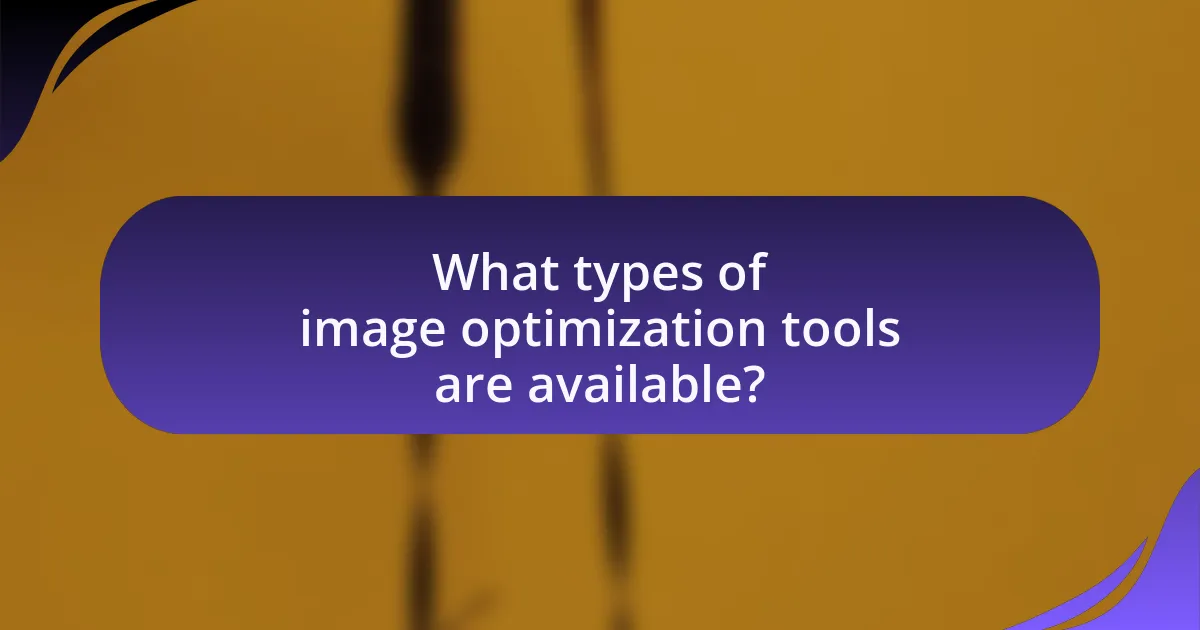
Various types of image optimization tools are available, including lossless and lossy compression tools, image resizing software, and format conversion utilities. Lossless compression tools, such as PNGGauntlet and ImageOptim, reduce file size without sacrificing quality, while lossy compression tools like TinyPNG and JPEGmini achieve smaller sizes by discarding some image data. Image resizing software, such as Adobe Photoshop and GIMP, allows users to adjust dimensions and resolution, enhancing performance for web use. Format conversion utilities, like CloudConvert and Zamzar, enable users to change image formats to optimize compatibility and loading times. These tools collectively enhance image performance and loading speed, which are critical for web usability and SEO.
What are the differences between lossy and lossless optimization tools?
Lossy optimization tools reduce file size by permanently eliminating some data, which can lead to a decrease in image quality, while lossless optimization tools compress files without any loss of data, preserving the original quality. For example, lossy formats like JPEG can achieve significant size reductions, often by up to 90%, but at the cost of detail, whereas lossless formats like PNG maintain all original image information, resulting in larger file sizes but higher fidelity. This distinction is crucial for users who need to balance quality and file size based on their specific requirements.
How does lossy optimization affect image quality?
Lossy optimization reduces image quality by permanently eliminating some data to decrease file size. This process can lead to visible artifacts, such as blurring or pixelation, especially at high compression levels. Studies have shown that excessive lossy compression can significantly degrade the clarity and detail of images, impacting their overall visual appeal and usability in professional contexts. For instance, JPEG compression, a common lossy format, can result in a loss of fine details and color accuracy, particularly in images with high contrast or intricate patterns.
What are the advantages of using lossless optimization?
Lossless optimization offers the advantage of reducing file size without sacrificing image quality. This method maintains the original data of the image, ensuring that visual fidelity remains intact while improving loading times and reducing storage requirements. For instance, tools like PNGGauntlet and ImageOptim utilize lossless techniques to compress images effectively, achieving size reductions of up to 50% without any noticeable loss in quality. This is particularly beneficial for web applications, where faster load times can enhance user experience and improve search engine rankings.
Which software options are best for beginners?
The best software options for beginners in image optimization include Adobe Photoshop Express, GIMP, and Canva. Adobe Photoshop Express offers a user-friendly interface with essential editing tools, making it accessible for novices. GIMP, while more advanced, provides extensive features and is free, allowing beginners to learn without financial commitment. Canva simplifies the design process with drag-and-drop functionality and pre-made templates, catering to users with minimal design experience. These options are widely recognized for their ease of use and effectiveness in image optimization tasks.
What features should beginners look for in image optimization software?
Beginners should look for user-friendly interfaces in image optimization software, as ease of use is crucial for those unfamiliar with technical processes. Additionally, essential features include batch processing capabilities, which allow users to optimize multiple images simultaneously, saving time and effort. Support for various file formats is also important, ensuring compatibility with different image types. Furthermore, built-in compression tools that balance quality and file size are vital, as they help maintain image integrity while reducing load times. Lastly, tutorials or customer support options can significantly enhance the user experience, providing guidance and assistance when needed.
How can beginners effectively use these tools?
Beginners can effectively use image optimization tools by following a structured approach that includes understanding the tool’s features, applying best practices, and regularly reviewing results. Familiarizing oneself with the specific functionalities of tools like Adobe Photoshop, TinyPNG, or ImageOptim allows users to leverage their capabilities for resizing, compressing, and converting images efficiently. For instance, using the batch processing feature in these tools can save time and ensure consistency across multiple images. Additionally, beginners should adhere to best practices such as selecting the appropriate file format (JPEG for photographs, PNG for graphics with transparency) and adjusting compression settings to balance quality and file size. Regularly reviewing the output quality and loading times of optimized images on websites can provide feedback on the effectiveness of the optimization process, ensuring continuous improvement in image handling.
How can users choose the right image optimization tool?
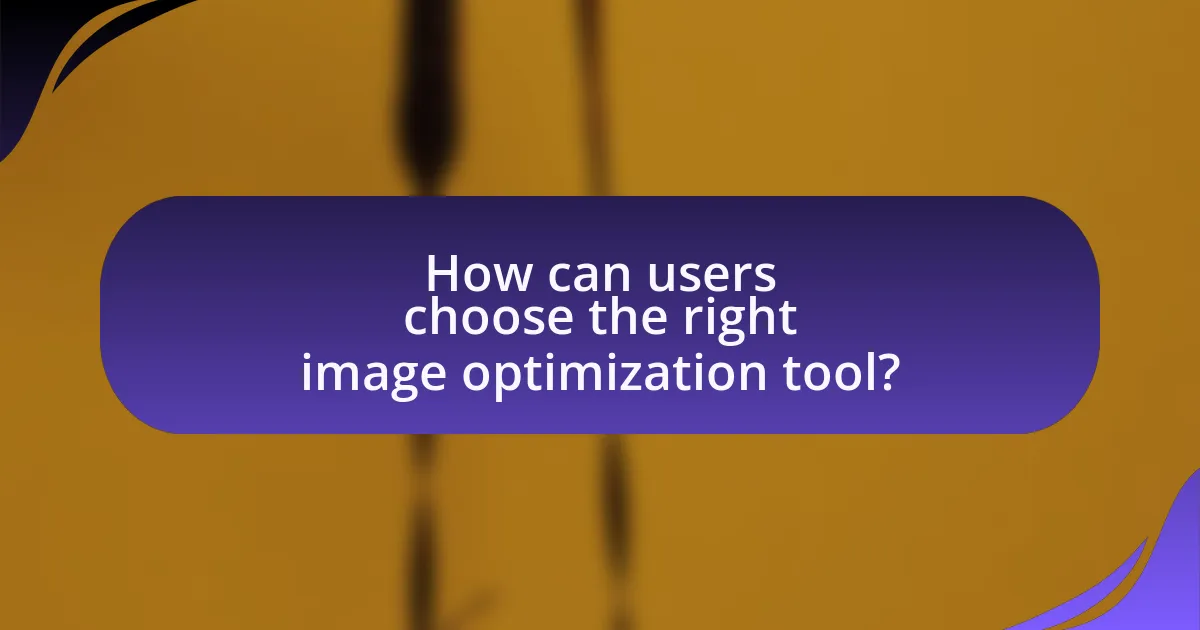
Users can choose the right image optimization tool by evaluating their specific needs, such as the types of images they work with, the desired output quality, and the tool’s compatibility with their workflow. For instance, tools like TinyPNG and ImageOptim are effective for web images due to their balance of compression and quality, while Adobe Photoshop offers advanced features for professional editing. Additionally, users should consider factors like ease of use, batch processing capabilities, and support for various file formats. Research indicates that tools that provide a clear user interface and automation features can significantly enhance productivity, making them preferable for users with high-volume image processing needs.
What factors should be considered when selecting an image optimization tool?
When selecting an image optimization tool, factors such as compression quality, supported file formats, ease of use, batch processing capabilities, and integration options should be considered. Compression quality is crucial as it affects the visual fidelity of images; tools like TinyPNG and ImageOptim are known for maintaining high quality while reducing file size. Supported file formats are important because different tools may handle formats like JPEG, PNG, and GIF differently, impacting versatility. Ease of use ensures that users can efficiently navigate the tool, which is essential for productivity. Batch processing capabilities allow users to optimize multiple images simultaneously, saving time, while integration options with existing workflows or platforms enhance usability and efficiency.
How does the intended use of images influence tool selection?
The intended use of images significantly influences tool selection by determining the specific features and capabilities required for effective image optimization. For instance, if images are intended for web use, tools that prioritize compression and fast loading times are essential, as studies show that a 1-second delay in page load time can reduce conversions by 7%. Conversely, for print media, tools that offer high-resolution output and color accuracy become critical, as print quality directly impacts brand perception. Therefore, the purpose of the images dictates the necessary functionalities of the tools, ensuring that the selected software aligns with the desired outcome.
What budget considerations should users keep in mind?
Users should keep in mind the total cost of ownership when budgeting for image optimization tools and software. This includes not only the initial purchase price or subscription fees but also potential costs for updates, maintenance, and additional features. For instance, many image optimization tools offer tiered pricing based on usage levels, which can significantly impact long-term expenses. Additionally, users should consider the return on investment (ROI) by evaluating how improved image optimization can enhance website performance and user experience, potentially leading to increased traffic and sales.
What are some common challenges in image optimization?
Common challenges in image optimization include balancing image quality with file size, ensuring compatibility across different devices and browsers, and managing the time required for processing large volumes of images. The need to maintain high visual fidelity while reducing loading times is critical, as studies show that a one-second delay in page load time can lead to a 7% reduction in conversions. Additionally, varying standards and formats across platforms can complicate the optimization process, making it essential to use tools that can adapt images accordingly. Lastly, the manual effort involved in optimizing numerous images can be time-consuming, highlighting the importance of automated solutions in streamlining this task.
How can users troubleshoot issues with image quality?
Users can troubleshoot issues with image quality by checking the resolution settings and ensuring they match the intended output requirements. High-resolution images should be used for print, typically 300 DPI, while lower resolutions, around 72 DPI, are suitable for web use. Additionally, users should inspect the file format; JPEGs may lose quality due to compression, while PNGs maintain higher fidelity. Users can also adjust brightness, contrast, and sharpness using image editing software to enhance clarity. Regularly updating software and drivers can prevent compatibility issues that may affect image rendering.
What strategies can be employed to overcome optimization challenges?
To overcome optimization challenges, employing techniques such as image compression, format selection, and responsive design is essential. Image compression reduces file sizes without significantly impacting quality, which enhances loading times and user experience. For instance, using tools like TinyPNG or ImageOptim can effectively decrease image sizes while maintaining visual fidelity. Selecting the appropriate image format, such as JPEG for photographs or PNG for graphics with transparency, further optimizes performance. Additionally, implementing responsive design ensures images are appropriately sized for different devices, improving load times and overall site efficiency. These strategies collectively address common optimization challenges by enhancing performance and user engagement.
What are best practices for effective image optimization?
Best practices for effective image optimization include using the appropriate file format, compressing images without significant quality loss, and implementing responsive images. Selecting the right file format, such as JPEG for photographs and PNG for graphics with transparency, ensures optimal quality and file size. Compression tools like TinyPNG or ImageOptim can reduce file sizes by up to 70% while maintaining visual fidelity. Additionally, using responsive images with the ‘srcset’ attribute allows for different image sizes to be served based on the user’s device, improving load times and user experience. These practices collectively enhance website performance and SEO, as studies show that faster loading times can lead to higher user engagement and lower bounce rates.
How can users ensure consistent quality across different platforms?
Users can ensure consistent quality across different platforms by utilizing standardized image formats and resolution settings. By adhering to specific guidelines, such as using JPEG or PNG formats with a resolution of at least 72 DPI for web use, users can maintain visual integrity across various devices. Research indicates that images optimized for web display should not exceed 100 KB in size to balance quality and loading speed, which is crucial for user experience. Additionally, employing tools like Adobe Photoshop or online platforms such as TinyPNG can help users compress images without significant loss of quality, ensuring uniformity in appearance across different platforms.
What tips can help maintain optimal performance while using image optimization tools?
To maintain optimal performance while using image optimization tools, ensure that you regularly update the software to benefit from the latest features and bug fixes. Keeping the tool updated enhances its efficiency and compatibility with various image formats. Additionally, utilize batch processing to optimize multiple images simultaneously, which saves time and resources. It is also crucial to select the appropriate compression settings based on the intended use of the images; for instance, using lossy compression for web images can significantly reduce file size without noticeable quality loss. Lastly, monitor system resources during optimization to prevent slowdowns; tools that consume excessive CPU or memory can hinder overall performance.
